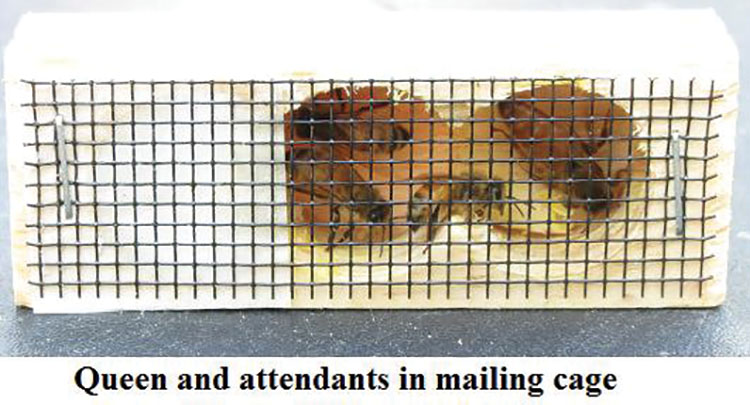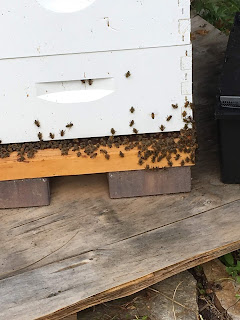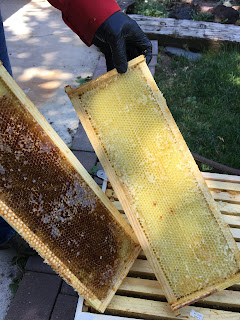Honey Harvest
Over the weekend we did a thing that comes in near the top of my "Coolest Things I've Ever Done" list. We harvested some honey!
 |
| Selfie with Hives |

Of course, we don't get to directly observe most bee action! The queen gets busy laying eggs, and the workers stay busy attending the eggs, prepping the brood cells, and keeping things orderly in the hive. We stand on the outside going "Wonder how they're doing."
We have been curious, because we have two hives, and in the heat only one of them has been "bearding" This is when the bees congregate outside the hive, collecting together en masse, and looking like a beard, truly. They do it when the interior of the hive gets too warm, and we, watching from the outside, thought there was a huge population in one hive, while the other colony might be dwindling because they just don't beard. But Wylie checked it out, and found that indeed, the non-bearding hive was flourishing as well.
 |
| Wylie Suiting Up |
 |
| Some equipment |
Lifting the top box off, and examining the slats, he found brood in the first four slats that he checked. We don't want to disturb the brood, so he left those slats.
| Brood Cells have dark domed caps |
 |
| Checking Slats |
 |
| Before we started |
 |
| After opening the hive. THAT is bearding. |
 |
| Gently brushing bees off into the hive |
 |
| Little dude emerging from brood cell. |
We got back to our processing area, and found that some of the honey was really dark, while other honey was pale and yellow. We figure this must be from different sources of nectar.
One slat that was 100% honey on one side had about a dozen brood cells on the other side. We didn't notice the brood cells among all the honey, or we would have left that frame in the hive. We could see the baby bees chewing their way through their domes, and I felt so bad! A few escaped before we put their slat in the extractor, but they didn't have other bees around, touching them and making them part of the hive. I did feel bad.
 |
| Slats going to be brought to the extractor |
Though we didn't get stung, we did have bees in our faces, and at one point I had a security detail herd me away from the hive. Mostly when bees hover nearby they're just sorta checking you out, but I had three or four bees come at me while I was watching the action at the hives. They were really in my face, bouncing off my head, and generally being much more...assertive...than a normal honey bee. I took the hint and moved away, and they let me be...except one. He wasn't happy until I went inside the house, and he escorted me all the way to the back door.
Helpful Hint: Waving your hands at bees whose hive is being disturbed does NOT make them go away.
The extractor is centrifugal, spinning the honey right out of its cells onto the walls. The honey then drips down the walls of the extractor to the base, where there is a "honey gate". Can you see the filter in the bucket?
 |
| the extractor |
 |
| Honey pours. Thank you, Bees! |
The extractor is centrifugal, spinning the honey right out of its cells onto the walls. The honey then drips down the walls of the extractor to the base, where there is a "honey gate". Can you see the filter in the bucket?
The filter is much needed, because there's wax, propolis, bee legs, and whole entire dead bees in there. They love their honey and some of them hung out around our processing area the whole time we were working. Of course they'd try to light on the honey and OF COURSE, they would get stuck in it. There was no saving them, and again I felt bad.
 |
Wylie did eventually put both gloves on |
The flavor is unique, again because their resources are varied, unlike the clover honey available in grocery stores. It's a stronger flavor, with depth or tone. I felt like it was a wine tasting. Another difference, at least in the several samples I lifted from the edges with my finger: Grocery store honey does NOT have bits of wax in it!
We estimate that we had a harvest of about 3 1/2 gallons, and had enough jars for 2 gallons, neat and tidy, and looking like champagne.











